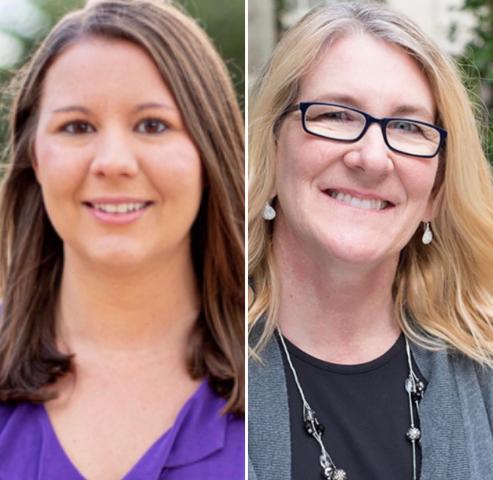Life during a global pandemic created new challenges for many schools. Faculty, staff, and students had to quickly adjust to online learning and all the new barriers that emerged. Those obstacles were even more pronounced for deaf students, who had to navigate new accessibility needs while transitioning to a virtual classroom.
Issues like the poor quality of auto captions, delays in access, technology struggles, and faculty resistance and awareness all added to the problems facing deaf students. In fact, approximately 74% of deaf college students considered online learning more difficult than traditional learning.
Many schools are now looking towards reopening their campus and returning to some version of “normal.” But the return to campus also holds new hurdles for deaf students.
To assist in this transition, the National Deaf Center for Postsecondary Outcomes (NDC) held the live panel Deaf Student Access: Tips & Resources for Reopening Campus, a presentation with members of our NDC | help team, Stephanie Zito, M.S., NIC and Lore Kinast, Ed.D., covering the most frequently asked questions about access and accommodations when supporting #DeafSuccess during school reopening.
Communication is Key
Effective communication is critical for deaf students to access the full college experience. Every student is different, so creating an interactive process with the student invites dialogue instead of relying solely on documentation.
NDC’s Interactive Process Tools are a great resource that can help you learn about what types of questions to ask to help understand the deaf student’s personal experiences. The checklist and sample questions walk through a discussion with the deaf student, asking about the student’s communication preferences, use of technology, and their familiarity with various accommodations.
After the disability services office initially meets a deaf student and agrees upon accommodations, that should not be the end of the process. Check in with the student regularly is a good practice, especially if the accommodations may be new or different for them. This is important because some students will let you know right away if something is not effective, but other students may not self advocate or feel comfortable asking for help.
Keeping those lines of communication open and building a relationship with the student is vital to providing the continued accessibility they need. This fosters a relationship of trust and support.
Find Communication Solutions for Face Masks
As institutions navigate the return-to-campus process, policies on face coverings may vary from community to community. With that in mind, our NDC | help team discussed the impact of this safety measure on deaf students.
Face masks block critical information for communication, such as mouth movements for lip-reading and facial expressions for sign language. They can also muffle speech for those relying on residual hearing.
Many disability services offices look toward clear masks as a solution but, in some cases, they may not provide complete access. Some face masks with a clear piece have distracting designs, fog up, or a small window that is hard to see from a distance. You may need to explore additional accommodations, such as remote services or different settings and logistical arrangements.
You may also encounter deaf students who primarily receive information by relying on their residual hearing, hearing aids, and cochlear implants. A common accommodation request may be for an Assistive listening system (ALS), such as an FM system, that reduces background noise and increases access to spoken information. ALS can enhance sound quality especially when masks are being used which can muffle voices.
Mask usage may just depend on the circumstance, protocol, or policy. When establishing these accommodations, it is important that you spend time working with both the student and faculty to set up a communication solution that is fully accessible and equitable.
Remote Services are Still Useful Tools on Campus
As the pandemic spread across the country, many institutions were unexpectedly forced to move online. Now that students may return to campus, colleges can use the experience gained over the past year to better plan how to use remote services and how best to provide accessibility for deaf students.
Arranging for remote services requires proactive planning. Achieving effective communication for deaf students involves matching the student’s communication preferences with the technical knowledge and skillset of the provider.
Remote services may also be new to the student and may require trial-and-error to get the right fit. It is also not just a matter of setting up a service provider but looking at all the variables that play into making this experience go smoothly for the student, faculty, peers, and service providers.
Also be sure to evaluate the technology and hardware needs. For example, accessibility features vary by platform, so familiarize yourself with the platforms being used within your school and that will be used with remote service providers. Making sure both the student and provider have the needed equipment to effectively use these platforms is also important.
Be proactive and connect with faculty before classes start and discuss the accommodations that will be put in place. They may need training on different platforms to ensure access is effectively provided to deaf students. If time permits, conduct a practice run with the instructor, provider, and student to determine what works best.
The real key to remote services is making sure they are successfully arranged before classes begin. Being in class and realizing there are access issues can cause a delayed participation process for the deaf student, create frustration for faculty, and require finding quick solutions that may not be as effective for the deaf student.
Provide Equitable Access to Media: Captioned Media Matters
Equitable access to media requires systematic and proactive planning. From pre-recorded lectures to educational videos or podcasts, a multimedia experience has become a regular part of many classes. As pointed out in the recent NDC panel Persevering Through Uncertainty: Stories from Deaf Students, students do not want to wait until after the fact to obtain information because it has an impact on their learning.
Quality of captions is equally important as the availability of captions. Auto-captions are often unreliable and inaccurate, so they are not an equitable tool for deaf students. Similarly, written transcripts should be checked for accuracy. When looking at accessibility, also consider adding ASL interpretation to recordings and ensure quality captions on videos.
FAQs From the Field
Navigating these new and ever-changing campus situations can be challenging. It’s okay to not immediately have all the answers. You’re not alone in your back-to-school concerns or questions about how best to serve your deaf students. The panel included a Q&A that helped answer some common questions from people just like you.
Many times, technology requirements can be a hurdle. What can be done for students who are in rural areas that do not have stable internet access?
There are local, state and federal programs that support getting access to high speed internet. Some students have also used public facilities like libraries to access stable internet. Some institutions provided technology such as mobile hotspots or worked with providers and schedulers to maximize time on campus if they are traveling long distances. You can find more helpful information in our NDC Serving Deaf Students in Rural Communities guide.
Another common question is about new technologies that are available. Can technology like Otter.Ai or AVA replace a CART provider?
The first step when wondering about the efficacy of a technology is to ask the deaf student. Deaf students should always determine whether or not an accommodation is effective for them. With that in mind, Automatic Speech Recognition (ASR) technology is unpredictable in its reliability, accuracy, and effectiveness. The deaf student should also tell you in what situations it may still be effective. For example, for a last-minute, impromptu discussion with an instructor, ASR technology may help fill a gap when service providers are not available. However, ASR is not recommended for classroom settings, either online or in-person, and may actually increase barriers to communication.
But what if the student thinks effective communication access is not being provided? What is the best way to find a solution?
The first and most important step is to invite students back into the communication process, which should be ongoing to create a safe space to talk about issues like this that may arise. As soon as a student discloses an accommodation is not effective, the DS professional and student can discuss what the options are and work towards a solution to find the right accommodation for them.
Have More Questions? NDC is Here to Help
As your campus adapts to this new normal, continue to have a dialogue with your deaf students on how you can best support an equitable educational experience. To assist you in that, NDC has the following helpful resources:









